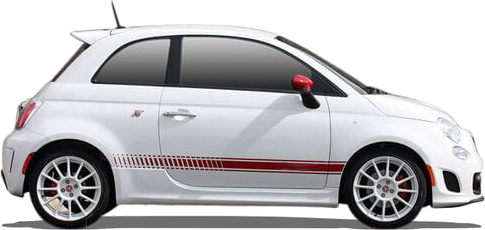The Comparative Analysis :
Abarth 595 (16 - 19) vs. Hyundai i10 1.2 Automatic (17 - 19)
€ 20,000

€ 14,700

€ 20,000
Base Price ⓘBase price of a new vehicle with standard equipment in Germany at market launch.
€ 14,700
ⓘBase price of a new vehicle with standard equipment in Germany at market launch. Price Info
Vehicle Dimensions
The Abarth 595 is a little smaller in every dimension. It's 0.5 cm shorter, 3.3 cm narrower and 1.5 cm lower than the Hyundai i10 1.2.
Abarth 595
Hyundai i10 1.2
1485
1627
1893
1500
1660
1970
1627 mm
Width
1660 mm
1893 mm
Width Incl. Mirrors
1970 mm
1485 mm
Height
1500 mm
2300
3660
2385
3665
3660 mm
Length
3665 mm
2300 mm
Wheelbase
2385 mm
Vehicle Weight
Abarth 595
Hyundai i10 1.2
1120 kg
Kerb Weight
1036 kg
1425 kg
Gross Vehicle
Weight
Weight
1455 kg

Weight Difference:
84 kg
7.5 %

General
Abarth 595
Hyundai i10 1.2
ZAF 312
Generation
IA
Hatchback
Car Body Style
Hatchback
Unleaded (95 RON)
Fuel Type
Unleaded (95 RON)

Front-wheel drive
Drive
Front-wheel drive

5-speed manual transmission
Transmission
4-speed automatic transmission
Engine
Abarth 595
Hyundai i10 1.2
Straight-four petrol engine with turbocharger
Engine Type
Straight-four petrol engine (naturally aspirated engine)
312 B4.000
Engine Code
4
Valves
4
4
Cylinders
4
1368 CC
Engine Capacity
1248 CC
143 bhp
at 5500 rpm
Power
86 bhp
at 6000 rpm
Abarth 595
143 bhp
86 bhp
Hyundai i10 1.2
206 NM
at 3000 rpm
Max. Torque
121 NM
at 4000 rpm
Abarth 595
206 NM
121 NM
Hyundai i10 1.2
Performance
Abarth 595
Hyundai i10 1.2
130 mph
Maximum Speed
101 mph
7.8 sec
Acceleration 0 to 62 mph
13.8 sec
62 mph
62
mph
mph
108 m
0.000 sec

Abarth 595
62 mph
62
mph
mph
192 m
0.000 sec

Hyundai i10 1.2
▶ REPLAY
7.83 kg/bhp
Weight-to-Power Ratio
12.05 kg/bhp
Abarth 595
7.83 kg/bhp
12.05 kg/bhp
Hyundai i10 1.2
Fuel Economy / Emissions
Abarth 595
Hyundai i10 1.2
Fuel Economy
42 mpg
combined
48 mpg
Abarth 595
42 mpg
48 mpg
Hyundai i10 1.2
32 mpg
city
38 mpg
No data
motorway
56 mpg
35 L
Fuel Tank Capacity
40 L
324 mi
Range
421 mi
Abarth 595
324 mi
421 mi
Hyundai i10 1.2
Environmental Impact
127 kWh
Total Energy Consumption
per 100 miles ⓘThe total energy consumption per 100 miles is the amount of energy consumed by a vehicle when burning fuel or using electricity per 100 miles (final energy), and the energy required to produce the appropriate amount of fuel or electricity (primary energy).
per 100 miles ⓘThe total energy consumption per 100 miles is the amount of energy consumed by a vehicle when burning fuel or using electricity per 100 miles (final energy), and the energy required to produce the appropriate amount of fuel or electricity (primary energy).
111.8 kWh
Abarth 595
127 kWh
111.8 kWh
Hyundai i10 1.2
Euro 6d-TEMP-EVAP (WLTP)
Emission Standard
Euro 6
154 g/km (NEFZ)
CO2 Emissions
139 g/km (NEFZ)
Practical Convenience
Abarth 595
Hyundai i10 1.2
3
Doors
5
4
No. of Seats
5
305 kg
Maximum Payload
419 kg
185 L
Boot Capacity
252 L





610 L
Boot Capacity (Seats Down)
1046 L





















